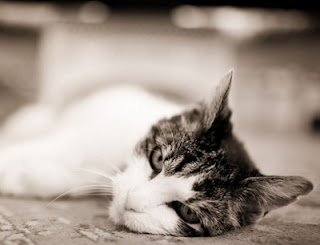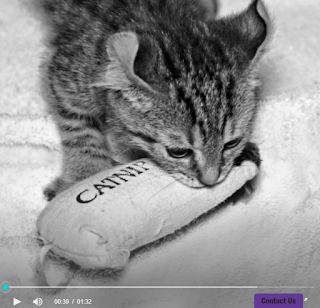3 Facts About Cat Purring
Purrs are wonderful, right? There’s you and your kitty, sitting
together, with you cuddling and your pet purring. It’s classic
contentment.
But purring is really rather a mysterious and complex behavior.
#1 First of all, nobody is sure how the purr works. One theory is that the hyoid, a horseshoe shaped bone in the back of the throat is involved.
People who support this idea classify cats into roaring cats and purring cats, pointing out that big cats like lions, tigers and jaguars roar but don’t purr, whereas domestic cats purr but don’t roar.
Now, this looks like a useful idea because the roaring cats have a soft hyoid whereas pet cats all have a hard hyoid.
As is typical with cats though, there’s a problem: snow leopards have a soft hyoid but they purr!
#2 We all know what the happy purr looks like. This is when your pet is having a seriously good time, like maybe being stroked or waiting for something particularly yummy to eat.
With happy purring there’s usually a little light swaying, that gentle eye squeezing that is the traditional “cat kiss” and there may be a little raspberry tongue showing. Many cats also knead, so much so that you may have to insert a cushion between you and your precious fur baby.
#3 There’s the panic purr. You’ll hear that in the vet’s office when your pet is quite rigid with fear, and the purrs are loud and uneven, rasping rather than pleasant.
Some speculate that this is how a cat tries to calm himself, like us maybe singing a happy song to cheer ourselves up. Some studies also suggest cats can improve bone density and promote healing by purring.
Curious isn’t it? Cats are truly miracles of nature.
But purring is really rather a mysterious and complex behavior.
#1 First of all, nobody is sure how the purr works. One theory is that the hyoid, a horseshoe shaped bone in the back of the throat is involved.
People who support this idea classify cats into roaring cats and purring cats, pointing out that big cats like lions, tigers and jaguars roar but don’t purr, whereas domestic cats purr but don’t roar.
Now, this looks like a useful idea because the roaring cats have a soft hyoid whereas pet cats all have a hard hyoid.
As is typical with cats though, there’s a problem: snow leopards have a soft hyoid but they purr!
#2 We all know what the happy purr looks like. This is when your pet is having a seriously good time, like maybe being stroked or waiting for something particularly yummy to eat.
With happy purring there’s usually a little light swaying, that gentle eye squeezing that is the traditional “cat kiss” and there may be a little raspberry tongue showing. Many cats also knead, so much so that you may have to insert a cushion between you and your precious fur baby.
#3 There’s the panic purr. You’ll hear that in the vet’s office when your pet is quite rigid with fear, and the purrs are loud and uneven, rasping rather than pleasant.
Some speculate that this is how a cat tries to calm himself, like us maybe singing a happy song to cheer ourselves up. Some studies also suggest cats can improve bone density and promote healing by purring.
Curious isn’t it? Cats are truly miracles of nature.
See more at - http://www.2pawsupinc.com/recent-blog/




Comments
Post a Comment